
- Homepage
- Antique
- Material
- Object Type
- Style
- Adams (7)
- Antique (3)
- Art Deco (1393)
- Art Déco (14)
- Art Nouveau (13)
- Cane (8)
- Cane, Walking Stick (4)
- Clutch (3)
- Contemporary (4)
- Evening Bag (4)
- French (5)
- Handle (4)
- Mid-century Modern (23)
- Modern (5)
- Oriental (19)
- Purse (33)
- Shoulder Bag (7)
- Tote (4)
- Vintage / Retro (3)
- Walking Stick (30)
- Other (830)
- Sub-type
- Type
Danish Art Deco Metalware Just Andersen, Sleek Two-Handled Vase, Disko Metal

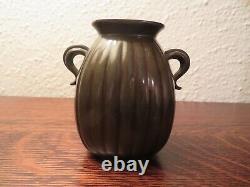
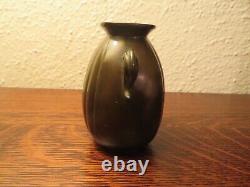
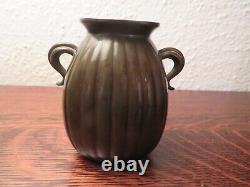
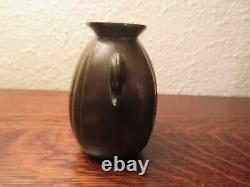
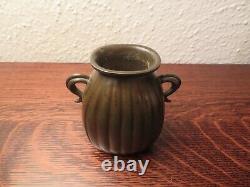
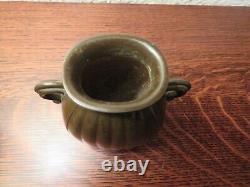

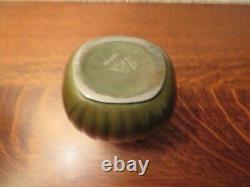
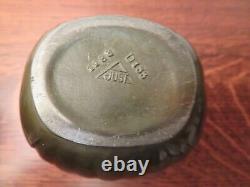

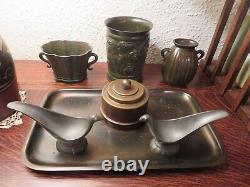


Danish Art Deco Metalware: Just Andersen, Sleek Two-Handled Vase, Disko Metal. He is best known for his candleholders, vases, and figurines using pewter, brass, copper, and Disko, an alloy Andersen invented by combining lead and antimony. Born on July 13, 1884 in Godhavn, Greenland, Andersen studied at the Royal Academy of Art in Copenhagen before attending the School of Danish Crafts under Jens Moeller-Jensen. Upon finishing school, he designed works for Georg Jensen. And in 1918 opened his own silversmith company, Just Andersen Pewter.
Andersen died on December 11, 1943 in Glostrup, Denmark. His works are in the collections of the Metropolitan Museum of Art in New York and the National Museum in Stockholm, among others. Andersen's parents were Martha Elisabeth Ingeborg Carlsen and Niels Alfred Andersen. His father was an inspector and shift leader in North Greenland, where Just Andersen spent the first ten years of his life. In 1894 he moved with his family to Denmark, where his father died in 1900. Just Andersen had his first apprenticeship as a decorative sculptor. With Hans Christian Lamberg Petersen. Before completing his studies at the Royal Art Academy and then the School of Danish Crafts. He married Alba Mathilde Happiness, who was a chaser for Mogens Ballin in 1915 and later worked for Georg Jensen. In his early career, Andersen designed for the silversmith Georg Jensen, the jeweler Anton Michelsen and the goldsmith P. Inspired by the silversmiths the couple worked for, he opened Just Andersen Pewter in 1918. In 1929 he transformed his company into a public limited company.Just Andersen had his own show rooms in Berlin, London, New York and Los Angeles. Axel Zacho, an immigrant from Denmark, who operated his store on Wilshire Boulevard from the 1930s until his death in 1955, after which it was run by his son until 1962.
In 1934 Andersen designed Blok flatware for Jensen. In addition to his metalwork, Andersen also produced ceramic articles and ceramic sculptures. From 1940 he made a series of statuettes of Nexø sandstone and cement. The company closed after the death of the widow in 1973. Andersen is associated with the Art Deco movement in Denmark and is best known for his neoclassic Scandinavian design of articles for everyday use in pewter, brass, copper, bronze and Disko. Disko Metal is an alloy of lead and antimony, which was Andersen's own invention, was named after the Disko Bay of Greenland, where he grew up.It was used to produce "Bronze" items, such as candlesticks, vases, sculptures and models in the foundry, because it was more affordable than real bronze. After being cast the pieces were patinated as bronze, copper or brass. This lovely bud vase with two handles is. Of Just Andersen's Art Deco style work in Disko metal.
The vertical ribbed decoration and serpentine handles make for a very elegant form. While precise dating of Just Andersen's work is difficult, I would guess that this piece dates from the 1930s.
This lovely piece is very well marked with Just Andersen's "Just" shopmark, D133 (with the D referring to Disko), and the number 1186 or 1188? , which probably also is related to the vase form. The dimensions of this piece are about 3.5 inches high, 3.5 inches wide, and about 2.5 inches deep. With no significant observed flaws. See photos more more details on the condition of this piece, which would be a nice addition to any collection of Just Andersen Danish metalware.
I will be listing a total of six pieces of Just Andersen this week. Those interested can see all my current Just listings in the last two photos. The bulk of my collection is Danish stoneware from the 1920s into the 1970s.The bulk of my Danish collection consists of Arne Bang, Saxbo, Jais Nielsen, Nils Thorsson, Erik Hjorth, and Ejvind Nielsen. I have done extensive research on these and other artists and workshops and would be happy to share that with interested buyers. In addition to stoneware, I have a modest collection of Danish Art Deco metalware from the workshop of Just Andersen.
Over the coming months I will be listing a wide range of pieces from my collection, including a selection of metalwork by Just Andersen in light bronze, pewter, and Disko metal. Please check out my other listings and add me to your list of saved sellers to receive notification of new listings.
